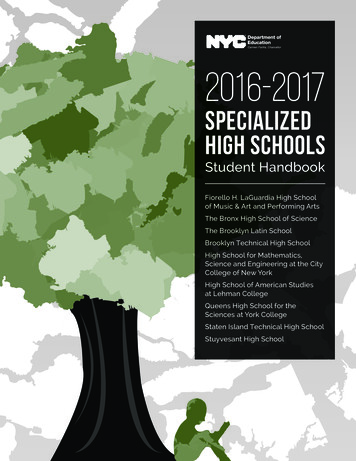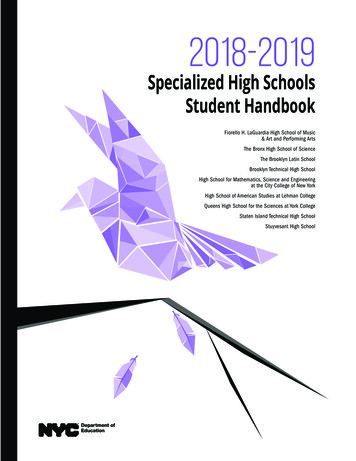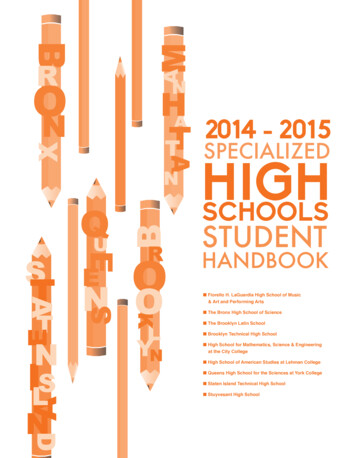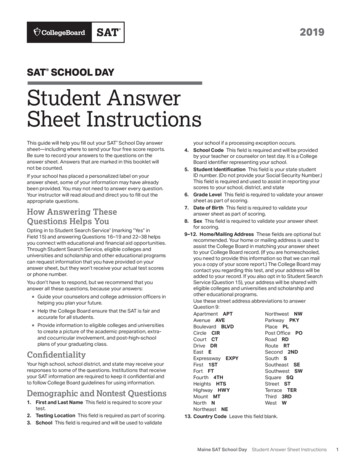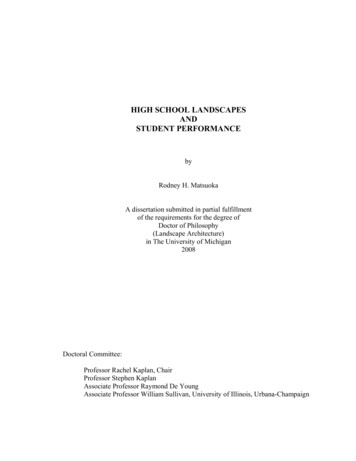
Transcription
HIGH SCHOOL LANDSCAPESANDSTUDENT PERFORMANCEbyRodney H. MatsuokaA dissertation submitted in partial fulfillmentof the requirements for the degree ofDoctor of Philosophy(Landscape Architecture)in The University of Michigan2008Doctoral Committee:Professor Rachel Kaplan, ChairProfessor Stephen KaplanAssociate Professor Raymond De YoungAssociate Professor William Sullivan, University of Illinois, Urbana-Champaign
Rodney H. Matsuoka2008
I wish to dedicate this dissertation to the memoriesof my father, mother, and stepmother.ii
AcknowledgmentsTo Professor Rachel Kaplan for her guidance throughout the dissertation process.To Professors Stephen Kaplan, Ray De Young, and William Sullivan for their greatassistance.To Rackham Graduate School and the School of Natural Resources & Environmentfor providing the funding which made this research possible.And, to my wife Stacy for her understanding and support throughout the past six years.iii
Table of ContentsDedicationAcknowledgmentsList of FiguresList of TablesList of duction1Physical Environments and Student Performance5III. Method22IV. The High School Campuses of Different Socio-EconomicGroups39V.Natural Landscape Features and Student Performance50VI. Beneficial and Non-Beneficial Campus Landscape Features65VII. Conclusions78AppendicesReferences93100iv
List of .2The Locations of Lenawee, Livingston, Monroe, Oakland, Washtenaw,and Wayne Counties in the State of MichiganNon-Caucasian Student Population Shown by Geographic Location(2004-2005)Distribution of Schools by Age of Buildings and Geographic LocationSchool Enrollment by Geographic Location (2004-2005)Campus Boundaries and Areas MeasuredExamples from the Least Advantaged High School GroupExamples from the Least Advantaged High School GroupExamples from the Moderately Advantaged High School GroupExamples from the Moderately Advantaged High School GroupExample from the Most Advantaged High School GroupExample from the Most Advantaged High School GroupDistribution of Student Disorderly BehaviorDistribution of Student Criminal Activityv22252627314444454546475354
List of 5.35.45.55.65.7Bordering Neighborhood SitesCampus Site AreasCampus Natural FeaturesStudent Potential Access to NatureStudent Scholastic Achievement for the Academic School Year2004-2005Factor Analysis of the Eleven Types of Student DisorderStudent Behaviors for the Academic School Year 2004-2005School Demographics and Location by Economic AdvantageSchool Location by Economic Advantage CrosstabulationLand Uses Bordering Schools by Economic AdvantageCampus Site Characteristics by Economic AdvantageStudent Performance Grouped by Economic AdvantageStudent Performance Regressed onto Regional and NeighborhoodCharacteristicsStudent Performance Regressed onto Campus Natural CharacteristicsStudent Performance Regressed onto Building FeaturesStudent Performance Regressed onto School PoliciesCorrelations among Predictors from the Four Regression ModelsStudent Performance Regressed onto All Four Categories of 758596162
List of AppendicesAppendixABThe Public High Schools Examined in this StudyDefinitions of the Six Public High School Student CriminalActivities Used in this Studyvii9499
AbstractHigh school students today are experiencing unprecedented levels of schoolrelated stress. At the same time, a growing body of research has linked views of andaccess to natural features with stress reduction and restoration from mental fatigue. Howimportant are such views and access to students while they are at school? This studyinvestigated 101 public high schools in southeastern Michigan to examine the role playedby the availability of nearby natural environments in the academic achievement andbehavior of high school students. All analyses controlled for student socio-economicstatus, racial/ethnic makeup, building age, and size of enrollment. The results reveal thatnature exposure beneficially affects student performance. Specifically, views withgreater quantities of natural features (e.g., trees, shrubs) from classroom as well ascafeteria windows were associated with higher standardized test scores, graduation rates,and percentages of students planning to attend college, and lower occurrences of criminalbehavior. In addition, school policies of allowing students to eat lunch outdoors and toleave campus during lunch were related to enhanced test scores and college plans.This study also investigated the influences that specific features of the high schooland surrounding landscapes can have on students. Greater quantities of viewable naturalfeatures near student lunch sites were found to be positively related to test scores,graduation rates, and intentions to attend college. In addition, the results suggest that thetrees and shrubs viewed from the lunch sites and classroom windows need to be close tothe viewer to be of greater benefit. Finally, large expanses of landscape lacking innatural features had a negative influence on test scores, intentions to attend college, andcollege plans. Such landscapes included large areas of lawn, parking lots, and borderingfarmlands.viii
Prior research concerning the relationships between school physical environmentsand student performance has concentrated mainly on indoor characteristics of the schoolbuilding and kindergarten or elementary school playscapes. This study’s results,however, demonstrate that campus landscape features that are primarily looked at ratherthan more directly experienced can have just as much influence on high school students’academic achievements and behaviors.ix
Chapter IIntroductionTeenagers throughout the United States spend a substantial amount of time inhigh schools. How important are views of nature from high school classrooms andcafeterias and access to nature during the school day to student performance?Surprisingly, there appears to be little information to answer this question.In other contexts, research has shown the important role played by views of andaccess to nearby nature. These studies have linked such views and access with a widevariety of beneficial effects, including greater work productivity and mental functioning,improved health and sense of well-being, and enhancements in social interactions andsocially acceptable behaviors. In light of this evidence it would seem reasonable toexpect that contact with landscape features and more natural sites, including trees, shrubs,lawns, and woodlands should enhance student performance in terms of both scholasticachievement and behavior.This chapter provides a brief introduction to the problem and an overview of thestudy. A more extensive review of the literature with respect to the role played by nearbynature and the issues that have been studied in the school context are provided in the nextchapter.Study BackgroundThe physical environment of schools has received attention with respect tostudent performance. Most of these studies, however, have concentrated on the indoor1
characteristics of school buildings and classrooms. For example, research has addressedindoor features including lighting, noise, indoor air quality and temperature, building age,and the maintenance of indoor facilities (Earthman & Lemasters, 1996; Evans, 2006;Weinstein, 1979; Woolner, Hall, Higgins, McCaughey, & Wall, 2007). The role playedby natural features of the outdoor campus environment has been examined in a handful ofstudies, but most of these have looked at how more natural playscapes positivelyinfluence the development of elementary school students (Herrington & Studtmann,1998; Neville, 1994; Owens, 1997). Of the two studies that have investigated the effectsof viewing natural landscape features from campus building windows, one focuses ondormitories at a university (Tennessen & Cimprich, 1995), while the other took place atelementary schools (Heschong Mahone Group, 2003a). Results of both of these studiesshow that greater levels of vegetation in the views are linked with better student academicachievement and mental functioning. Neither study, however, examined the specificcomposition of the natural features contributing to the outcomes, nor was the distance tothe natural elements considered, leaving many questions unanswered. For example, areviews of trees, shrubs, and lawn equivalent in the benefits they provide? Are the effectsof the view affected by how distant the natural environment is? Answers to questionssuch as these could be useful in designing high school campuses.Study OverviewThe purposes of this study are both to gain an understanding of the role played byviews of nearby nature with respect to high school students' performance, and to lookmore specifically at the effects that certain natural features of high school landscapes canhave. This investigation into student potential exposure to nature consisted of two parts.First, the landscape features that exist on each campus and in the surroundingneighborhood were inventoried. Tree density, areas of shrubs and lawns, the sizes ofparking lots and athletics fields, and the presence of more natural landscapes borderingeach campus are among the landscape elements that were assessed. Second, studentpotential access to these landscape features was investigated. This access was measuredby calculating the window areas of classrooms and school cafeterias, analyzing the sites2
provided for students to eat lunch in, and inspecting school policies associated withstudent contact with the outdoor environment.The influences of both student exposure and access to nature were assessed withrespect to student performance. These performance variables were examined at theschool level, relying on publicly available information about students’ scholasticachievement as well as their conduct. To the extent that access to nearby nature isbeneficial for this age group, one would expect nature availability to be reflected inhigher achievement and reduced misbehavior.High schools were chosen for this study rather than elementary and middleschools for a variety of reasons. They tend to be larger in scale, thus incorporating agreater variety of landscape features and layouts. In addition, most of the prior researchconcerning the outdoor physical environments of schools has involved elementaryschools. The findings of this study will provide information about a much lessresearched student age group and campus environment. Furthermore, given that highschool dropout rates are substantial in so many American cities and satisfaction with thehigh school experience is quite low (Campbell & College, 2003; Freeman, 2004;Thomas, 2008), exploring the potential of the high school landscape as a factor in studentperformance would seem constructive.How much influence can we realistically expect the outdoor environment to haveon students? Insights into this question can be obtained by analyzing the findings ofstudies concerned with indoor characteristics of school buildings. For example,researchers have found that students in substandard buildings score 5-10% lower onstandardized tests than students in functional buildings. Other studies have found thatbuilding conditions could also account for about 3-6% of the variance in test scores inmultiple regression analyses (Earthman, 2004; Mayer, Mullens, & Moore, 2000; NationalResearch Council, 2006; Schneider, 2002; Woolner et al., 2007).3
Studies have suggested that the influence of the physical environment on studentsis less than that of other factors such as student socio-economic status and ethnic/racialbackground, teacher quality, and peer group characteristics (Woolner et al., 2007).Researchers, nevertheless, contend that building characteristics will “reliably affecthundreds or thousands of students over the life of the building, typically fifty years.Since the design of classrooms is entirely within the control of the school district, muchmore so than student or teacher demographics, optimized design of schools should be acentral concern for all new school construction” (Heschong Mahone Group, 2003a, p. xi).Following this same logic, campus landscapes will also be experienced bythousands of students during the life of the school building. In fact, elements of thelandscape may last longer than the buildings themselves. In addition, the cost to improvelandscapes is usually much less than that to renovate buildings. If an increasecomparable to the 5-10% improvement in student performance due to better buildings canalso be demonstrated for better landscapes, improving the latter may indeed be worthconsideration by school administrators.4
Chapter IIPhysical Environments and Student PerformanceThis chapter opens with a review of the benefits that contact with nature canprovide for people. The emphasis in examining this literature is on the benefits providedby viewing rather than more directly interacting with nature (e.g., gardening, camping,climbing trees). During the course of a typical school day, a view is the only type ofnature contact that most high school students will likely experience. The second sectionof the chapter examines school related stresses and anxieties that many high schoolstudents are currently experiencing. In light of these negative situations, contact withnature may be of great importance for today’s high school students. The third section ofthe chapter reviews work on student background and social dimensions, as well as schoolresource factors, to highlight the substantiated important role that these issues play instudent performance. In light of their strong impact, the effects of these factors werecontrolled for in the statistical analyses that were used in this study to explore therelationships between nature contact and student performance. This chapter closes with adiscussion of the study’s hypotheses which were based on the findings of past research.These hypotheses served as the foundation for the methods used to investigate schoollandscapes.Benefits of Contact with NatureThe many benefits that views of and access to natural features in the landscapecan have on people has been revealed primarily in contexts other than the schoolenvironment. The findings in these nonschool settings are presented first to provide anoverview of these positive effects. Studies have been conducted in places where peoplework and reside, as well as where individuals are hospitalized and imprisoned. Next, the5
small number of studies that have taken place at schools are examined. This is followedby a discussion of the nature contact that students may experience while commuting toand from school. Lastly, the explanations proposed by various researchers for thebenefits provided by viewing and experiencing nature are looked at.Nonschool SettingsWithin the workplace, researchers have documented that views of nature areassociated with increased employee productivity, enhanced feelings of job and lifesatisfaction, greater psychological and physical well-being, and reduced levels offrustration and stress (Heerwagen & Wise, 1998; Heschong Mahone Group, 2003b; R.Kaplan, 1993; Leather, Pyrgas, Beale, & Lawrence, 1998). Views out of an office orfactory window with greater vegetation content and/or size of the view available havebeen associated with a corresponding increase in many of these benefits for workers(Heschong Mahone Group, 2003b; R. Kaplan, 1993; Leather et al., 1998). Indirectevidence of the importance of views of nature from the workplace for workerproductivity and well-being is provided by other research. First, a large body of researchhas established that the ability to see out of the building is desired by office employeesand is an important factor in their working environment (Brill, 1984; Collins, 1975;Manning, 1965; B. W. P. Wells, 1965; Wotton & Barkow, 1983; Young & Berry, 1979).Distant views or views with natural elements (e.g., sky, natural vegetation, water) arepreferred to those lacking these features (Ludlow, 1976; Markus, 1967).Second, workers with a window view are more productive (Collins, 1975;Figueiro, Rea, Stevens, & Rea, 2002; Hedge, 1995; Young & Berry, 1979) and possessgreater satisfaction with their jobs and physical working conditions (e.g., visualappearance, lighting, temperature, comfort) (Brill, 1984; Cuttle, 1983; Farrenkopf &Roth, 1980; Finnegan & Solomon, 1981; Hedge, 1995; B. W. P. Wells, 1965; Wyon &Nilsson, 1980) than their windowless counterparts. Increased sense of well-being hasalso been reported for employees who have a window view (Collins, 1975; Cuttle, 1983;Hedge, 1995; Ludlow, 1976; Young & Berry, 1979).6
Third, studies have revealed that office workers favor daylight as the primarysource of illumination (Cuttle, 1983; Heerwagen & Heerwagen, 1986; Langdon, 1966;Manning, 1967; Markus, 1967; Veitch & Gifford, 1996; B. W. P. Wells, 1965).Furthermore, daylight has positive impacts on work attitudes and experiences(Heerwagen & Heerwagen, 1986; Heerwagen & Wise, 1998) as well as feelings ofrelaxation (Boubekri, Hull, & Boyer, 1991). Nonetheless, Ne’eman (1974) found thatworkers prefer a pleasant view (e.g., nice park) through their windows more than indoorsunshine.Fourth, employees occupying windowless offices were found to have morepictures of natural scenes on their walls than occupants of windowed spaces, possibly asa way of compensating for the lack of real natural scenes (Heerwagen & Orians, 1986;Sommer, 1974).In the residential context, studies have revealed that views of and exposure tonearby natural features can increase resident’s cognitive abilities (Kuo, 2001; Taylor,Kuo, & Sullivan, 2002; Tennessen & Cimprich, 1995; N. M. Wells, 2000), sense of wellbeing (R. Kaplan, 2001), and satisfaction with their neighborhood and residences (R.Kaplan, 2001; Kearney, 2006; Talbot & Kaplan, 1991). In addition, Wells and Evans(2003) report that exposure to nearby nature buffer the impact of life stress on children.Among residents of an inner-city public housing complex, higher levels of nearbyvegetation (e.g., trees, grass) have been associated with greater social interaction, and areduction in aggression, violent behaviors, and crime (Coley, Kuo, & Sullivan, 1997;Kuo & Sullivan, 2001a, 2001b; Kuo, Sullivan, Coley, & Brunson, 1998).Within diverse settings, views of nature through a window or in a painting havebeen associated with benefits to physical health. These benefits include a reduction inhealth care needs by prison inmates (Moore, 1981), shorter postoperative hospital stays(Ulrich, 1984), and a decrease in pain experienced both during a medical procedure andafter surgery (Diette, Lechtzin, Haponik, Devrotes, & Rubin, 2003; Ulrich, Lundén, &Eltinge, 1993).7
In summary, a growing body of research results suggests that views of andexperiences with nearby nature may provide many social, psychological, and physicalhealth benefits. Although most of these studies have taken place in workplace,residential, and hospital settings, one might reasonably expect the benefits to also applyin other settings, particularly in schools.School SettingsResearch concerning the physical environment of schools has focused primarilyon building features and interior spaces. Only a handful of studies have directlyinvestigated how features of the natural environment in the campus landscape caninfluence student behavior. “The periodical review suggests [that there has been] limitedinterest in improvements to the design of exterior spaces at high schools” (Owens, 1997,p. 158). Alternative outdoor settings have received some empirical attention, but thesestudies have examined playgrounds in preschool, kindergarten, and elementary school.In these contexts natural playscapes have been found to benefit children’s creative playand social, emotional, cognitive, and motor development (Fjørtoft, 2004; Fjørtoft &Sageie, 2000; Herrington & Lesmeister, 2006; Kirkby, 1989; Lindholm, 1995). Thenumber of even these studies, though, is small (Herrington & Studtmann, 1998; Neville,1994).Heschong Mahone Group (2003a) conducted the only previous study that lookedat the effects of classroom window views on student performance. They examined theattributes of 500 elementary school classrooms in thirty-six schools. Ample views (i.e.,100 sq ft of window area or greater per classroom) that included vegetation (i.e.,primarily trees or bushes) or human activity (e.g., playground, lunch area, parking lot),and objects in the far distance were found to be associated with higher scores onstandardized tests.While I did not find any research that examines nature contact in the high schoolcontext, the Tennessen and Cimprich (1995) study offers confirmation of the benefits ofnature views in a school setting. Their investigation of the effects of view content from8
dormitory windows on college students showed that more natural views were associatedwith better mental concentration abilities.Other than these two studies, there has been very little investigation concerninghow views of nature from school campus buildings might affect student performance.While not considering the contents of the views, some studies have examined the relatedtopics of the effects of windowed versus windowless classrooms (Cooper & Ivey, 1964;Demos, Davis, & Zuwaylif, 1967; Douglas & Gifford, 2001; Heschong, Wright, & Okura,2002; Larson, 1965) and daylighting (Heschong et al., 2002; Heschong Mahone Group,1999; Küller & Lindsten, 1992; Nicklas & Bailey, 1997). The results of investigationsinto the effects of windowless classrooms and daylighting on student scholasticachievement, behavior, mental health, and attitudes towards school have been conflicting(Collins, 1975; Edwards & Torcellini, 2002; National Research Council, 2006; Weinstein,1979). Benefits of windowless classrooms reported by students and teachers includefreedom from outside noise and distractions, more wall space for bulletin boards andbookcases, and more even lighting and thermal levels. Advantages of windowedclassrooms include the provisions of a view, natural lighting, and knowledge about theweather, and student self-reports of greater productivity and less stress. In her review ofthe research, Weinstein (1979) concluded that “evidence supports neither the claim thatwindowless classrooms will allow increased concentration, leading to higher achievement,nor the fear that the absence of windows will have harmful psychological and physicaleffects” (p. 592). Similarly, Collins (1975, p. 18) assessed that “some students like thesituation [windowlessness], others, possibly a majority, would prefer to have windows.The most striking conclusion seems to be the absence of significant findings, either pro orcon.”Concerning daylighting, some researchers claim that students in daylit classroomsdemonstrate enhanced scholastic achievement, better sociability, higher concentrationlevels, and lower sick leave rates as compared to students in windowless classrooms(Heschong et al., 2002; Heschong Mahone Group, 1999; Küller & Lindsten, 1992;Nicklas & Bailey, 1997). However, other researchers contend that some of these studies9
suffer from methodological flaws or are statistically unreliable (Boyce, 2004; Evans,2006). Reviewers of daylight research have concluded that “because of inconsistentresults and the small number of well-designed studies, there is insufficient evidence atthis time to determine whether or not an association exists between daylighting andstudent performance” (National Research Council, 2006, p. 40).Nature Exposure while Commuting to SchoolStudies indicate that viewing and experiencing more natural environmentspromote feelings of general well-being, and reduction and recovery from stress andmental fatigue (Berto, 2005; Cimprich & Ronis, 2003; Hartig, Evans, Jamner, Davis, &Gärling, 2003; Hartig, Mang, & Evans, 1991; Herzog, Black, Fountaine, & Knotts, 1997;R. Kaplan & Kaplan, 1989; S. Kaplan, 1995; Parsons, Tassinary, Ulrich, Hebl, &Grossman-Alexander, 1998; Ulrich, 1981; Ulrich et al., 1991). The percentage of qualitygreen space (e.g., urban green space, agricultural space, natural green space) inresidential environments has also been found to have a positive association with theperceived general health of residents. This relation is stronger for residents with lowersocio-economic status as compared with people of high socio-economic status, for theelderly and youth than adults, and for housewives (De Vries, Verheij, Groenewegen, &Spreeuwenberg, 2003; Maas, Verheij, Groenewegen, De Vries, & Spreeuwenberg, 2007;Mitchell & Popham, 2007). While these studies have not specifically addressed the teenyears, it is reasonable to expect that the findings would apply to this age group as well.High school students experience different levels of nature in their neighborhoods duringtheir daily commute to school, while they walk, cycle, drive, or ride in a car or bus.Explanations for these Nature BenefitsResearchers have advanced varied explanations for why contact with natureresults in improvements to work performance, mental functioning, health, general wellbeing, social interactions, child behaviors, and residential satisfaction. Two of the mostwidely cited explanations are the attention restoration theory and the psycho-evolutionarytheory. In addition, preference for natural features may play a role in enhancing studentperformance and satisfaction with the school physical surroundings.10
Attention restoration theory proposes that contact with nature has the potential torestore the directed attention capabilities of the brain (R. Kaplan & Kaplan, 1989; S.Kaplan, 1995). Directed attention fatigue, or mental fatigue, occurs when the capacity tofocus or concentrate is reduced by overuse. This fatigue can be the result of a stressresponse, can lead to a stress response, or then again can occur simultaneously withstress. An individual experiencing such fatigue not only may have a decreased ability toconcentrate, but also may become more irritable, distractible, impulsive, antisocial, andaccident prone. The theory contends that recovery from directed attention fatigue is aprerequisite for an individual to be able to function effectively. A decrease in mentalfatigue has been proposed as an explanation for increases in test scores (HeschongMahone Group, 2003a) and cognitive functioning (Kuo, 2001; Taylor et al., 2002;Tennessen & Cimprich, 1995; N. M. Wells, 2000), satisfaction with work and residentialsettings (R. Kaplan, 1993, 2001), senses of well-being of both adults (R. Kaplan, 1993,2001; Leather et al., 1998) and children (N. M. Wells & Evans, 2003), and socialinteractions and socially acceptable behaviors (Coley et al., 1997; Kuo & Sullivan, 2001a,2001b).In addition to sleep, recovery from directed attention fatigue can take place withinenvironments that support mental restoration. As proposed by the attention restorationtheory, such settings possess the characteristics of fascination, a sense of being away,extent, and compatibility (S. Kaplan, 1995). Fascination is an alternative form ofattention that does not require effort and allows directed attention to rest. Many forms offascination exist and are derived from a variety of sources. One important characteristicof fascination involves the continuum from “soft” to “hard.” Soft fascination occurs, forexample, when an individual is viewing natural features or strolling in a natural setting.This type of attention is effortless, permits an individual to rest his or her directedattention, and allows one to think about other things and reflect on unresolved issues.Hard fascination takes place, for example, when one is viewing television, attending abasketball game, or watching people at a shopping mall. Similar to soft fascination, hardfascination is effortless and allows directed attention to rest. However, hard fascinationfills the mind with alluring distractions and does not allow the individual to think about11
and reflect on unresolved issues. In addition, to be softly fascinating setting, a settingmust be beautiful and, as a result, pleasurable to the individual experiencing it. Thisbeauty-based pleasure helps one to reflect about confusing, discomforting, fearful, orotherwise painful (i.e., opposite of pleasurable) issues. Thus, a softly fascinating settingis beautiful, promotes the reflection process, and lessens any pain that may be involved(S. Kaplan, 1993). The ability to reflect is a key provision of mentally restorativeenvironments.A sense of being away allows an individual to escape from a mental activityinvolving the fatiguing use of directed attention. Extent requires that the restorativeexperience has enough scope “to engage the mind” and “be rich enough and coherentenough so that it constitutes a whole other world” (S. Kaplan, 1995, p. 173). Finally,attention restoration theory hypothesizes that the environment must be compatible withan individual’s goal of being mentally restored. Compatibility involves a match betweenone’s inclinations or purposes and the demands of the environment. In other words, aparticular surrounding needs to “fit what one is trying to do and what one would like todo” (S. Kaplan, 1995, p. 173).The psycho-evolutionary theory postulates that immediate, subconsciousemotional responses play a key role in an individual’s initial reaction to the environment.This initial reaction is affective, innate, cross-cultural, and mostly automatic withoutextensive cognition and information processing. The visual properties of theenvironment influence this response. These properties involve gross structuralcomponents, gross depth properties, and general classes of environmental content (e.g.,vegetation, water). The emotional response influences ps
First, the landscape features that exist on each campus and in the surrounding neighborhood were inventoried. Tree density, areas of shrubs and lawns, the sizes of parking lots and athletics fields, and the presence of more natural landscapes bordering each campus are among the landsc
